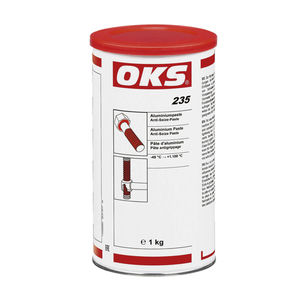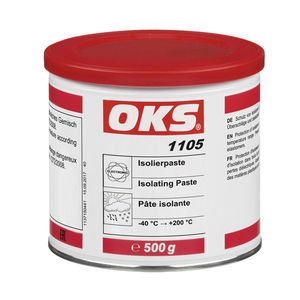
- Materials - Tools - Components
- Semi-finished products
- Lubricant paste
- OKS Spezialschmierstoffe GmbH
- Company
- Products
- Catalogs
- News & Trends
- Exhibitions
Lubricant paste OKS 265syntheticlithium soapfor chuck jaws

Add to favorites
Compare this product
Characteristics
- Function
- lubricant
- Material
- synthetic, lithium soap
- Applications
- for chuck jaws
- Other characteristics
- anti-corrosion, for heavy loads
Description
Fully-synthetic chuck jaw paste for lubricating friction and sliding points under high and impact-loaded loads.
Areas of application
Long-term lubrication of dirt-sensitive sliding points under vibration stresses
Particularly suitable for lubricating chucks on tool machines
Broad range of uses at stress-loaded parts, also at contact with cooling lubricants
Lubrication of control and drive mechanisms
Can be used at filling, labelling and packaging machines
Advantages and benefits
Resistant to water, steam and aqueous cooling lubricants
Prevents frictional corrosion reliably
Highly effective due to optimum solid lubricant combination
Minimal consumption due to formation of highly effective lubricating films
Technical specifications
lower operating temperature: -45 °C
upper operating temperature: 110 °C
four-ball test rig welding load: 4,200 N
thread friction coefficient (μ total): 0.1 (screw ISO 4017 M10x55-8.8 black-oxide, nut ISO 4032 M10-10 black-oxide)
Applications
For optimum adhesion, clean contamination and other lubricants from thread and slide surfaces. Best way is to clean mechanically first and then with OKS 2610/OKS 2611 universal cleaner. Apply sufficient paste evenly to the functional surfaces with a brush, spatula, etc. The paste will also act as a sealant. Do not use paste instead of grease and mix only with suitable lubricants.
Industries
No matter what industry you come from, we at OKS have the right solution for you.
Catalogs
No catalogs are available for this product.
See all of OKS Spezialschmierstoffe GmbH‘s catalogsRelated Searches
- OKS metal spray
- Protective spray
- Hard cleaning job detergent
- Cleaning cleaning product
- Additive
- OKS plastic spray
- Anti-corrosion spray
- Lubricant spray
- Wire coating
- Coating for industrial applications
- OKS lubricant paste
- OKS high-temperature paste
- Metal coating
- Corrosion protection coating
- Degreasing spray
- Metal cleaning product
- Solvent spray
- OKS assembly paste
- OKS metal paste
- Water-based cleaning product
*Prices are pre-tax. They exclude delivery charges and customs duties and do not include additional charges for installation or activation options. Prices are indicative only and may vary by country, with changes to the cost of raw materials and exchange rates.





















